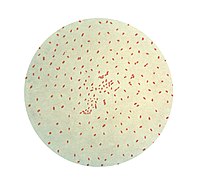
Photo from wikipedia
Abstract The novel coronavirus COVID-19 follows transmission route and clinical presentation of all community-acquired coronaviruses. Instead, the rate of transmission is significative higher, with a faster spread of the virus… Click to show full abstract
Abstract The novel coronavirus COVID-19 follows transmission route and clinical presentation of all community-acquired coronaviruses. Instead, the rate of transmission is significative higher, with a faster spread of the virus responsible of the worldwide outbreak and a significative higher mortality rate due to the development of a severe lung injury. Most noteworthy is the distribution of death rate among age groups. Children and younger people are almost protected from severe clinical presentation. Possible explanation of this phenomenon could be the ability of past vaccinations (especially tetanic, diphtheria toxoids and inactivated bacteria as pertussis) to stimulate immune system and to generate a scattered immunity against non-self antigens in transit, as coronaviruses and other community-circulating viruses and make immune system readier to develop specific immunity against COVID-19. The first support to this hypothesis is the distribution of mortality rate during historical pandemics (“Spanish flu” 1918, “Asian flu” 1956 and “the Hong Kong flu” 1968) among age groups before and after the introduction of vaccines. The immunological support to the hypothesis derives from recent studies about immunotherapy for malignancies, which propose the use of oncolytic vaccines combined with toxoids in order to exploit CD4+ memory T cell recall in supporting the ongoing anti-tumour response. According to this hypothesis vaccine formulations (tetanus, diphtheria, Bordetella pertussis) could be re-administrate after the first contact with Covid-19, better before the development of respiratory severe illness and of course before full-blown ARDS (Acute Respiratory Distress Syndrome). The CD4+ memory exploiting could help immune system to recall immunity of already know antigens against coronaviruses, avoiding or limiting “lung crash” until virus specific immunity develops and making it faster and prolonged. Finally, this administration could be helpful not only in already infected patients, but also before infection. In fact, people could have an immune system more ready when the contact with the COVID-19 will occur.
Journal Title: Medical Hypotheses
Year Published: 2020
Link to full text (if available)
Share on Social Media: Sign Up to like & get
recommendations!